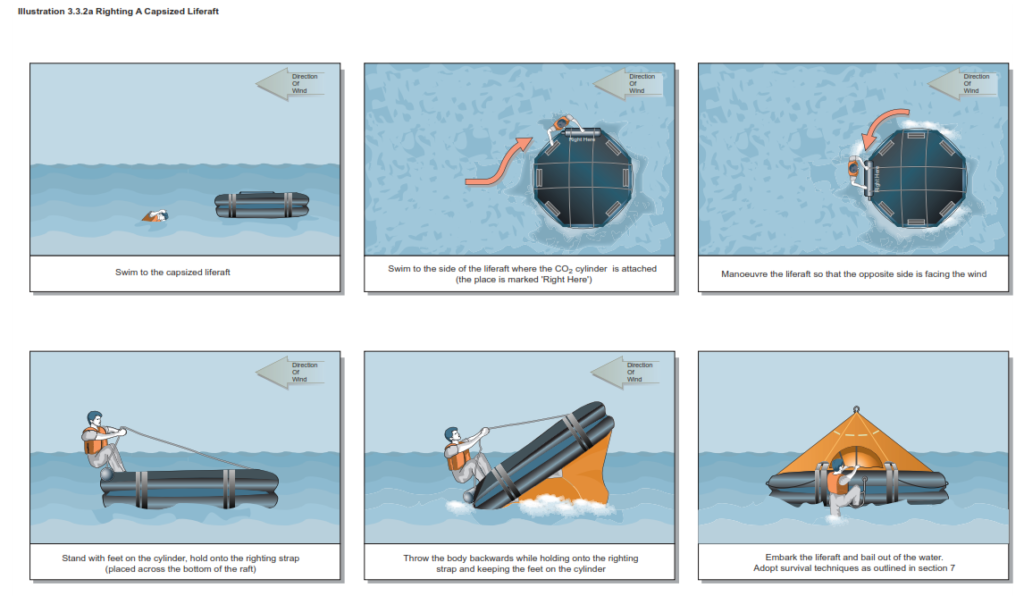There are four sixteen person liferafts stowed close by each lifeboat on the main deck and one 6 man liferaft located just aft of the bosun’s store entrance on the forward main deck.
The 16 man liferafts which each weigh 135kgs when empty and the 6 man liferaft situated behind a weather shield weighs 74kgs.
All the liferafts are constructed with twin buoyancy chambers, one above the other. The top and bottom sections may have their inflation topped up by bellows if necessary. The rafts are provided with boarding steps and ladders, internal and external gripping lines, capsize stabilisers and an automatic battery for both internal and external lighting.
Accessories supplied in each of the rafts are of the ‘type A’ pack and include:
• Buoyant rescue quoit with 30m of line
• Knife and bailer
• Sponges
• Sea anchors
• Buoyant paddles
• Repair kit
• Pump
• Safety tin openers
• First aid kit
• Drinking vessel
• Torch (and spares)
• Heliograph
• Parachute flare
• Hand flare
• Fishing kit
• Food and water rations
• Scissors
• Anti seasickness tablets
• Immediate action leaflet
• Rescue signal table
• Whistle
• Buoyant smoke flares
• Dye marker
• Seasickness bags
• Thermal protective aids

Release of the Rafts
Hydrostatic Release Units (HRU) are fitted to each of the aft rafts. The forward raft has no HRU. These will activate when submerged to a depth of two to four metres, releasing the rafts to float towards the surface. These HRUs will activate when submerged to a depth of two to four metres, releasing the rafts to float towards the surface.
The HRUs comply with IMO resolution A521 and the 1983 amendments to SOLAS 1974. They do not require any in-service maintenance but they must be renewed every two years.
After activation of the HRU, the raft is still secured to the vessel by a weak link. After inflation, sufficient drag is applied to break the weak link and allow it to float free.
The rafts may be released manually by unfastening the slip hook securing the lashing round the container. Ensure the ring on the end of the painter is still attached to the HRU, or a strong point on the ship’s deck.
When the raft is thrown over the side, the painter is pulled out until the carbon dioxide cylinder is activated and the raft inflates.
Procedure if an Empty Raft Should Capsize
Note: The side of the raft where the carbon dioxide cylinder is attached lies deepest in the water. The place is marked ‘right here’.
a) Stand with the feet on the cylinder, hold onto the righting strap (placed across the bottom of the raft).
b) Manoeuvre the raft so that the opposite side is facing into the wind.
c) Throw the body backwards while holding onto the righting strap and keeping the feet on the cylinder.
When the wind is very strong, the lifeline can be tied around the waist to prevent the raft being blown away.
A non-swimmer should keep hold of the righting strap and allow the raft to fall back on him (the rubber raft will not injure him). He can then work his way back to the raft entrance under water, holding onto the strap of the lifeline.
If automatic inflation does not work:
d) Swim up to the container, tear off the black rubber bands between the brass rings on the two nylon bands and release raft by pulling the release wire or use the bellows placed inside the raft.
The valves for inflation by means of the bellows are inside the raft and are coloured yellow.
Life-raft HRU and Weak-link Arrangement
Operation
a) After boarding the raft, the painter must be cut with the knife provided to avoid the raft being pulled under.
b) Paddle away from the danger zone using the paddles placed in a bag close to the entrance of the raft.
c) Alternatively one of the lifeboats could be used to tow the raft clear.
When the raft is full of survivors, others can hold onto the lifeline around the raft. The raft is capable of supporting double the number of persons it is certified to carry.
d) When clear of the danger zone, stream the sea anchor or drogue.
The sea anchor stabilises the raft and helps to minimise drift.
e) Inflate the canopy and the bottom of the raft as this gives excellent insulation against the cold. To do this connect the bellows to each topping up valve in turn, which are placed in the raft floor and inner canopy.
The bellows are located in a bag at the entrance.
After a long stay in the raft it may be necessary to top up the two buoyancy tubes.
f) Connect the bellow’s plastic tube to the yellow topping up valves.